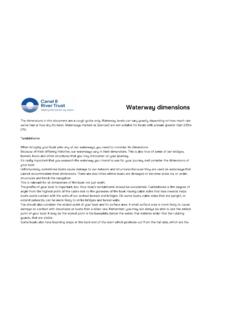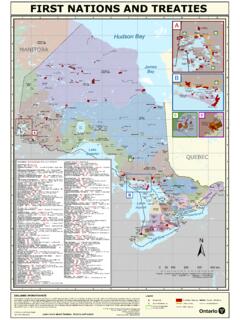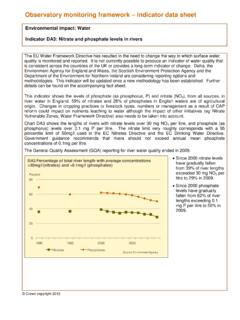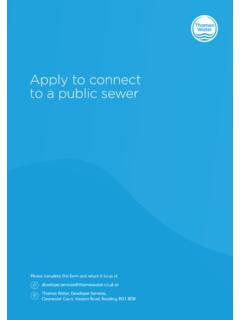Transcription of 2 Municipal Wastewater, Sewage Sludge, and Agriculture
1 2 Municipal wastewater , Sewage Sludge, and AgricultureHISTORICAL PERSPECTIVESW astewaterLarge-scale cropland application of Municipal wastewater was first practiced about 150 yearsago after flush toilets and sewerage systems were introduced into cities in western Europe and NorthAmerica. The wastewater was discharged without any treatment, and receiving watercourses becameheavily polluted. The problem is illustrated by the situation in London in the 1850s when the "stink"from the river thames obliged the House of Parliament to drench their drapes in chloride of lime(Snow, 1936).
2 Water supplies drawn from the river below the Sewage outfall were found by Dr. JohnSnow to be the source of the cholera outbreaks of the period. The partial solution to the problem wasthe construction by Sir John Bazalgete of a vast interceptor along the north bank of the river thames ,creating the famed thames Embankment. This gave relief to central London, but moved the pollutionproblem downstream. Sir Edwin Chadwick, a lawyer and crusader for public health at the time, was astrong advocate of separate sanitary sewers, and he coined the slogan, "the rain to the river and thesewage to the soil." In this spirit, and to reduce pollution of the thames downstream, " Sewage farms"were es-tablished to take the discharges from the interceptor.
3 The agricultural benefits from the farmswere incidental to their service in the disposal of the practice of Sewage farms quickly spread. By 1875, there were about 50 such farmsproviding land treatment in England, and many similar farms served major cities in Europe. By the turnof the century, there were about a dozen Sewage farms in the United States. However, the need for areliable outlet for wastewater was not entirely compatible with the seasonal nature of nutrient andwater requirements of crop production. While Sewage farms alleviated pollution in the receivingstreams, they created a different set of environmental sanitation problems.
4 Hydraulic and pollutantoverloading caused clogging of soil pores, waterlogging, odors, and contamination of food crops. Theperformance improved over the years as operators gained experience with balancing the needs ofwastewater disposal and crop growth. Nevertheless, the farms were gradually phased out when theland areas required to accommodate wastes from large cities grew too great to be practical and moreeffective technologies were developed to re-1718 The Use of Reclaimed Water and Sludge in Food Crop Productionmove pollutants from wastewater . The processes of primary sedimentation and secondary bio-logicaltreatment, which were developed in the early part of this century, required much smaller areas for theiroperations and were capable of producing clarified effluents for direct discharge into a surface waterbody.
5 These technologies eliminated the need for Sewage the United States, an estimated m3 (182 gal) per capita per day of municipalwastewater is generated (Solley et al., 1993). Municipal wastewater treatment plants (otherwiseknown as publicly-owned treatment works or "POTWs") currently serve around 75 percent of the (EPA, 1995). The remainder are largely served by individual household septic systems. For those served by centralized facilities, the Municipal wastewater is collected through a sewernetwork and centrally treated in a wastewater treatment plant. The collected wastewater containspollutants originating from households, business and commercial estab-lishments, and industrialproduction facilities.
6 The general composition of Municipal wastewater is well understood. For thepurpose of water-quality management, pollutants in Municipal wastewater may be classified into thefollowing five categories: Organic matter (measured as biochemical oxygen demand or BOD), Disease-causing microorganisms (pathogens), Nutrients (nitrogen and phosphorus), Toxic contaminants (both organic and inorganic), and Dissolved the exact composition may differ from community to community, all municipalwastewater contains constituents belonging to the above categories. Pollutants belonging to the samecategory exhibit similar water quality impacts.
7 The objective of wastewater treatment is to removepollutants so that the effluent meets the water quality requirement for discharge or modern society, thousands of potentially hazardous chemicals are used in householdproducts and commercial and industrial activities. They may be inadvertently or intentionallydischarged into the wastewater collection system. Municipal wastewater also contains many types ofinfectious, disease-causing organisms that originate in the fecal discharge of infected wastewater treatment, the physical and chemical state of pollutants determine theapproaches that are employed to remove impurities.
8 For this purpose, pollutants may be furtherclassified (as per Camp and Messerve, 1974) into: Settleable impurities, Suspended impurities, Colloidal impurities, and Dissolved sharing the same physical state behave similarly during conventional wastewater more than one hundred years of continuous development, Municipal wastewatertreatment technology in use today can achieve almost any degree of treatment and removal ofimpurities desired. The conventional Municipal wastewater treatment system consists of a series ofprocesses, through which pollutants are removed, step by step, from the water and are concentratedinto the solid fraction or sludge (see Chapter 3 for a further description of mun-icipal wastewater andMunicipal wastewater , Sewage Sludge, and Agriculture19sludge treatment).
9 Treated effluents are customarily discharged into a surface water body. With advances inwastewater treatment technology, wastewater effluents can achieve consistently high quality and areincreasingly reclaimed for reuse. The value of reclaimed water in crop irrigation has long beenrecognized, particularly where fresh water resources are limited (Webster, 1954; Mertz, 1956; Sepp,1971). Some wastewater reclamation programs ( , in Florida) are also motivated by the need toavoid nutrient overload to sensitive receiving waters. In these cases, beneficial reuse can be moreeconomical and/or technically feasible than employing the advanced wastewater treatment needed tomeet the requirements for surface water disposal.
10 In the United States, irrigating crops with reclaimed wastewater has been generally wellaccepted, both in the semiarid western states and in Florida. The suitability of water for reuse isinfluenced by the chemical composition of the source water, mineral pickup due to water use, and theextent of wastewater treatment. These characteristics vary seasonally and from one municipality toanother (Pettygrove and Asano, 1985). Dowdy et al. (1976) derived a "typical" chemical compositionof treated wastewater effluent from a selected number of cities. This "typical" composition iscompared to that of water from the Colorado river a source for crop production in several westernstates for many of the water quality criteria important in irrigation (Table ).



















